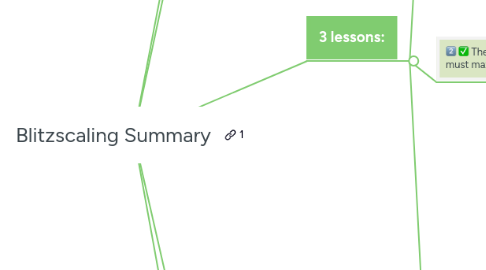
1. 1-Sentence-Summary:
1.1. Blitzscaling is the strategy some of today’s most valuable companies have used to achieve huge market shares, insanely fast growth, big profit margins, and become corporate giants in a very short time.
2. Favorite quote from the author:
2.1. "The world keeps getting faster - Silicon Valley is just the first place to figure out how to keep pace." - Reid Hoffman
3. 3 lessons:
3.1. Blitzscaling is not just about growing fast, it’s about doing so while staying sustainable.
3.1.1. Exponential growth is what every startup dreams about. But achieving it is neither simple nor always healthy.
3.1.2. For companies, side effects can occur when reaching one, ten, one hundred million users within just a few months.
3.1.3. That’s why Hoffman coined the term ‘blitzscaling’ to describe what it takes to survive this growth and mature successfully.
3.1.3.1. ‘Blitz’ is the German word for ‘lightning’ and hints at the speed of the expansion.
3.1.3.2. ‘Scaling’ separates into two components.
3.1.3.2.1. First, it’s about developing a company while keeping all parts in proportional sizes.
3.1.3.2.2. Second, it’s about reaching a massive scale of operations, serving thousands of customers or millions of users.
3.1.3.3. As a result, blitzscaling is the process of quickly scaling a company to a massive size and customer base while ensuring its sustainability of operations during exponential growth.
3.2. There are four growth factors companies must maximize to achieve blitzscaling.
3.2.1. Until recently, exponential growth was mostly about virality.
3.2.1.1. A few smart growth hackers could balloon a new company to a huge size with clever tricks and then the team could figure out a business model.
3.2.1.2. But it’s not so simple anymore.
3.2.2. According to Reid, there are now four growth factors, which, if combined well, can lead to blitzscaling.
3.2.2.1. Network effects.
3.2.2.1.1. The best networks become more useful for all involved participants with each new member.
3.2.2.2. Market size.
3.2.2.2.1. Startups need to select and dominate a niche to cross the chasm to mainstream consumers.
3.2.2.2.2. But if your total addressable market isn’t big enough, for example because it’s not online, you’ll soon run into growth limits.
3.2.2.3. Distribution.
3.2.2.3.1. The channels you pick for spreading your product must suit the speed of your expansion.
3.2.2.3.2. You can pick an existing distribution network, like Amazon did with the United States Postal Service, bet on organic virality thanks to word-of-mouth, or incentivize people to pass on the good word, like PayPal did with its $10 sign-up bonus.
3.2.2.4. High gross margins.
3.2.2.4.1. The more money you make per item sold, the better.
3.2.2.4.2. Sales is one of the hardest parts of scaling, so the more money you have left over after each transaction, the more you can reinvest.
3.3. The two biggest growth limiters for blitzscaling businesses are product-to-market fit and operational scalability.
3.3.1. Since it’s hard to guess exactly what your users want, there’s a high chance you’ll have to adjust your product after its release.
3.3.1.1. Many famous startups have pivoted several times before eventually finding the offering that allowed them to win.
3.3.1.2. Examples:
3.3.1.3. This isn’t a bad thing, it’s necessary, but founders have to be willing to do it.
3.3.2. Operational scalability, mostly depends on how much infrastructure, employees, and resources you need to deliver your product to more people.
3.3.2.1. For tech companies, this is often less of a problem than the manufacturers of physical goods.
3.3.2.2. If you can’t find enough suppliers, workers, or raw materials, those can quickly cut you off at the knees.
3.3.3. Make sure you address these issues from day one and maybe, you and your company can achieve blitzscaling.
